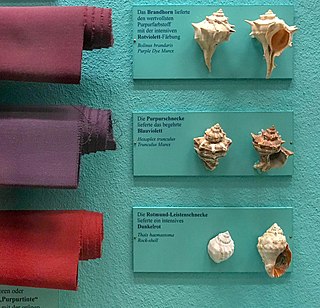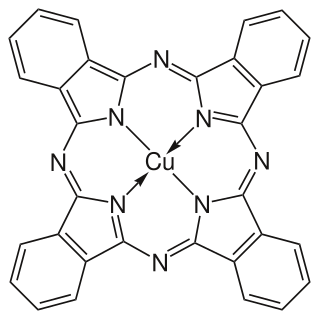
Tyrian purple, also known as royal purple, imperial purple, or imperial dye, is a reddish-purple natural dye. The name Tyrian refers to Tyre, Lebanon, once Phoenicia. It is secreted by several species of predatory sea snails in the family Muricidae, rock snails originally known by the name Murex. In ancient times, extracting this dye involved tens of thousands of snails and substantial labour, and as a result, the dye was highly valued. The colored compound is 6,6'-dibromoindigo.
Phycobilins are light-capturing bilins found in cyanobacteria and in the chloroplasts of red algae, glaucophytes and some cryptomonads. Most of their molecules consist of a chromophore which makes them coloured. They are unique among the photosynthetic pigments in that they are bonded to certain water-soluble proteins, known as phycobiliproteins. Phycobiliproteins then pass the light energy to chlorophylls for photosynthesis.

The California sea hare is a species of sea slug in the sea hare family, Aplysiidae. It is found in the Pacific Ocean, off the coast of California in the United States and northwestern Mexico.

The order Aplysiida, commonly known as sea hares, are medium-sized to very large opisthobranch gastropod molluscs with a soft internal shell made of protein. These are marine gastropod molluscs in the superfamilies Aplysioidea and Akeroidea.

Sea slug is a common name for some marine invertebrates with varying levels of resemblance to terrestrial slugs. Most creatures known as sea slugs are gastropods, i.e. they are sea snails that, over evolutionary time, have either entirely lost their shells or have seemingly lost their shells due to having a significantly reduced or internal shell. The name "sea slug" is often applied to nudibranchs and a paraphyletic set of other marine gastropods without apparent shells.
The Aplysia gill and siphon withdrawal reflex (GSWR) is an involuntary, defensive reflex of the sea hare Aplysia californica, a large shell-less sea snail or sea slug. This reflex causes the sea hare's delicate siphon and gill to be retracted when the animal is disturbed. Aplysia californica is used in neuroscience research for studies of the cellular basis of behavior including: habituation, dishabituation, and sensitization, because of the simplicity and relatively large size of the underlying neural circuitry.

Copper phthalocyanine (CuPc), also called phthalocyanine blue, phthalo blue and many other names, is a bright, crystalline, synthetic blue pigment from the group of dyes based on phthalocyanines. Its brilliant blue is frequently used in paints and dyes. It is highly valued for its superior properties such as light fastness, tinting strength, covering power and resistance to the effects of alkalis and acids. It has the appearance of a blue powder, insoluble in most solvents including water.

Hexaplex trunculus is a medium-sized sea snail, a marine gastropod mollusk in the family Muricidae, the murex shells or rock snails. It is included in the subgenus Trunculariopsis.

Aplysiidae is the only family in the superfamily Aplysioidea, within the clade Anaspidea. These animals are commonly called sea hares because, unlike most sea slugs, they are often quite large, and when they are underwater, their rounded body shape and the long rhinophores on their heads mean that their overall shape resembles that of a sitting rabbit or hare. Sea hares are however sea snails with shells reduced to a small plate hidden between the parapodia, and some species are extremely large. The Californian black sea hare, Aplysia vaccaria is arguably the largest living gastropod species, and is certainly the largest living heterobranch gastropod.

Aplysia is a genus of medium-sized to extremely large sea slugs, specifically sea hares, which are a kind of marine gastropod mollusk.

A rhinophore is one of a pair of chemosensory club-shaped, rod-shaped or ear-like structures which are the most prominent part of the external head anatomy in sea slugs, marine gastropod opisthobranch mollusks such as the nudibranchs, sea hares (Aplysiomorpha), and sap-sucking sea slugs (Sacoglossa).

Dolabrifera dolabrifera is a species of sea hare, a marine gastropod mollusc in the family Aplysiidae, the sea hares. Dolabrifera dolabrifera, otherwise known as a Warty Seacat. The animal goes by many names, including the common sea hare. The Hawaiian name for Dolabrifera dolabrifera, is Kualakai.

Aplysia dactylomela, the spotted sea hare, is a species of large sea slug, a marine opisthobranch gastropod in the family Aplysiidae, the sea hares.

Cephalopod ink is a dark-coloured or luminous ink released into water by most species of cephalopod, usually as an escape mechanism. All cephalopods, with the exception of the Nautilidae and the Cirrina, are able to release ink to confuse predators.

The spotted sea hare is a species of sea slug in the family Aplysiidae, the sea hares. It reaches a length of up to 20 cm (7.9 in) and is found in the northeast Atlantic, ranging from Greenland and Norway to the Mediterranean Sea.

Chemical defense is a strategy employed by many organisms to avoid consumption by producing toxic or repellent metabolites or chemical warnings which incite defensive behavioral changes. The production of defensive chemicals occurs in plants, fungi, and bacteria, as well as invertebrate and vertebrate animals. The class of chemicals produced by organisms that are considered defensive may be considered in a strict sense to only apply to those aiding an organism in escaping herbivory or predation. However, the distinction between types of chemical interaction is subjective and defensive chemicals may also be considered to protect against reduced fitness by pests, parasites, and competitors. Repellent rather than toxic metabolites are allomones, a sub category signaling metabolites known as semiochemicals. Many chemicals used for defensive purposes are secondary metabolites derived from primary metabolites which serve a physiological purpose in the organism. Secondary metabolites produced by plants are consumed and sequestered by a variety of arthropods and, in turn, toxins found in some amphibians, snakes, and even birds can be traced back to arthropod prey. There are a variety of special cases for considering mammalian antipredatory adaptations as chemical defenses as well.

Pain in invertebrates is a contentious issue. Although there are numerous definitions of pain, almost all involve two key components. First, nociception is required. This is the ability to detect noxious stimuli which evokes a reflex response that moves the entire animal, or the affected part of its body, away from the source of the stimulus. The concept of nociception does not necessarily imply any adverse, subjective feeling; it is a reflex action. The second component is the experience of "pain" itself, or suffering—i.e., the internal, emotional interpretation of the nociceptive experience. Pain is therefore a private, emotional experience. Pain cannot be directly measured in other animals, including other humans; responses to putatively painful stimuli can be measured, but not the experience itself. To address this problem when assessing the capacity of other species to experience pain, argument-by-analogy is used. This is based on the principle that if a non-human animal's responses to stimuli are similar to those of humans, it is likely to have had an analogous experience. It has been argued that if a pin is stuck in a chimpanzee's finger and they rapidly withdraw their hand, then argument-by-analogy implies that like humans, they felt pain. It has been questioned why the inference does not then follow that a cockroach experiences pain when it writhes after being stuck with a pin. This argument-by-analogy approach to the concept of pain in invertebrates has been followed by others.

Phagomimicry is a defensive behaviour of sea hares, in which the animal ejects a mixture of chemicals, which mimic food, and overwhelm the senses of their predator, giving the sea hare a chance to escape. The typical defence response of the sea hare to a predator is to release two chemicals - ink from the ink gland and opaline from the opaline gland. While ink creates a dark, diffuse cloud in the water which disrupts the sensory perception of the predator by acting as a smokescreen and as a decoy, the opaline, which affects the senses dealing with feeding, causes the predator to instinctively attack the cloud of chemicals as if it were indeed food. This ink is able to mimic food by having a high concentration of amino acids and other compounds that are normally found in food, and the attack behaviour of the predator allows the sea-hares the opportunity to escape.

Sea hares are gastropods without hard shells, using their specialized ink as their main defensive mechanism instead. Their ink has several purposes, most of which have a chemical basis. For one, the ink serves to cloud the predator's vision as well as halt their senses temporarily. In addition, the chemicals in the ink mimic food. Their skin and digestive tract are toxic to predators as well. They are also seen to change their feeding behaviours in response to averse stimuli.

Aplysia gigantea is a species of sea slug, a shell-less marine gastropod mollusk in the family Aplysiidae. The species was first described in the Journal of the Malacological Society of Australia in 1869. A. gigantea is also known more commonly as the sea hare due to their posterior chemosensory tentacles resembling a hare's ear. A. gigantea is the largest known species in Australia of the opisthobranch genus. The species is known to have toxic effects on terrestrial organisms, particularly domestic dogs. Exposure to this species with dogs has been associated with the development of neurotoxicosis, with symptoms ranging from respiratory distress to tremors, muscle fasciculations, and seizures.















